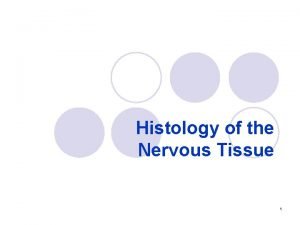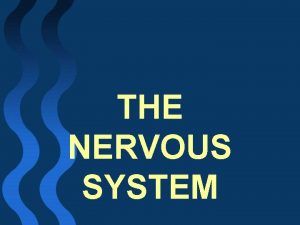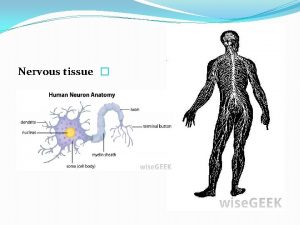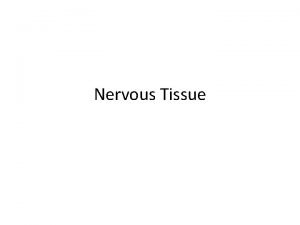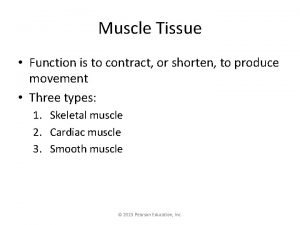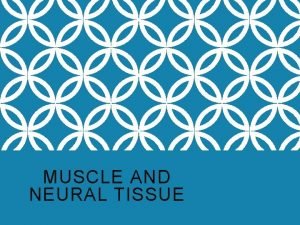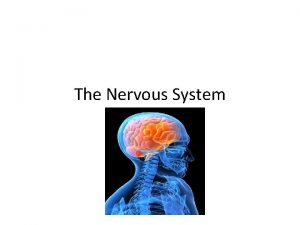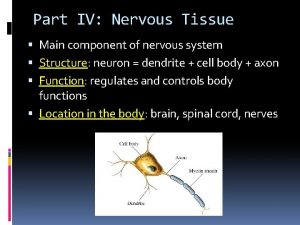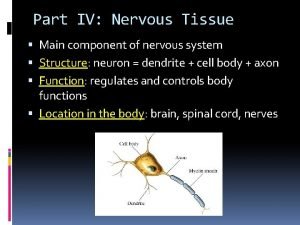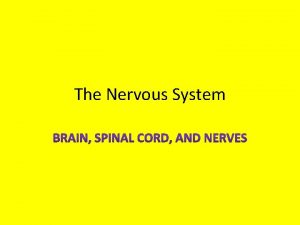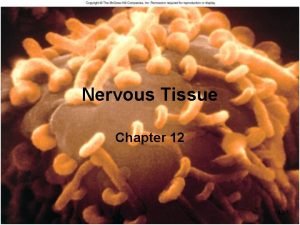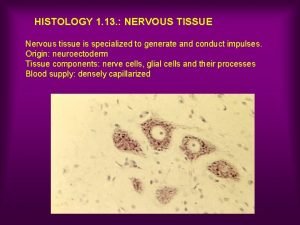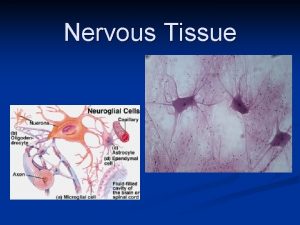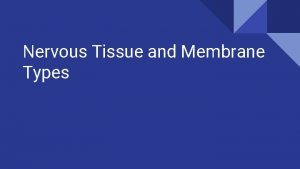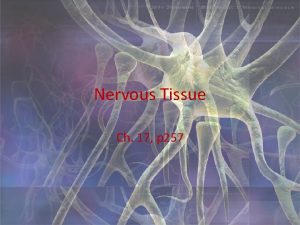Nervous tissue Nervous tissue is the main component















- Slides: 15

Nervous tissue �

Nervous tissue is the main component of the two parts of � the nervous system; the brain and spinal cord of the central nervous system (CNS), and the branching peripheral nerves of the peripheral nervous system (PNS), which regulates and controls bodily functions and activity. It is composed of neurons, or nerve cells, which receive and transmit impulses, and neuroglia, also known as glial cells, which assist the propagation of the nerve impulse as well as providing nutrients to the neuron. Nervous tissue is made up of different types of nerve cells, � all of which have an axon, the long stem-like part of the cell that sends action potential signals to the next cell. �

Functions of the nervous system are sensory input, � integration, control of muscles and glands, homeostasis, and mental activity. Structure � Nervous tissue is composed of neurons, also called nerve � cells, and neuroglial cells. Typically, nervous tissue is categorized into four types of tissue. In the central nervous system (CNS), the tissue types found are grey matter and white matter. In the peripheral nervous system (PNS), the tissue types are nerves and ganglia. The tissue is categorized by its neuronal and neuroglial components.

Components � Neurons are cells with specialized features that allow them � to receive and facilitate nerve impulses, or action potentials, across their membrane to the next neuron They possess a large cell body (soma), with cell projections called dendrites and an axon. Dendrites are thin, branching projections that receive electrochemical signaling (neurotransmitters) to create a change in voltage in the cell. Axons are long projections that carry the action potential away from the cell body toward the next neuron. The bulb-like end of the axon, called the axon terminal, is separated from the dendrite of the following neuron by a small gap called a synapse. When the action potential ravels to the axon terminal,


Nerve cells are functionally � connected to each other at a junction known as a synapse, where the terminal branches of an axon and the dendrites of another neuron lie in close proximity to each other but never make direct contact.

� Neurotransmitters are released across the synapse and bind to � the post-synaptic receptors, continuing the nerve impulse. Neurons are classified both functionally and structurally. � Functional classification: � �Sensory neurons (afferent): Relay sensory information in the form of an action potential (nerve impulse) from the PNS to the CNS �Motor neurons (efferent): Relay an action potential out of the CNS to the proper effector (muscles, glands) �Interneurons: Cells that form connections between neurons and whose processes are limited to a single local area in the brain or spinal cord

Structural classification: � Multipolar neurons: Have 3 or more processes coming off � the soma (cell body). They are the major neuron type in the CNS and include interneurons and motor neurons. �Bipolar neurons: Sensory neurons that have two processes coming off the soma, one dendrite and one axon �Pseudounipolar neurons: Sensory neurons that have one process that splits into two branches, forming the axon and dendrite Unipolar brush cells: Are excitatory glutamatergic � interneurons that have a single short dendrite terminating in a brush-like tuft of dendrioles. These are found in the granular layer of the cerebellum


cells that make up the primary immune system for the � CNS. Neuroglia encompasses the non-neural cells in nervous tissue that provide various crucial supportive functions for neurons. They are smaller than neurons, and vary in structure according to their function. Neuroglial cells are classified as follows � �Microglial cells: Microglia are macrophage They are the smallest neuroglial cell.

�Astrocytes: Star-shaped macroglial cells with many processes found in the CNS. They are the most abundant cell type in the brain, and are intrinsic to a healthy CNS. �Oligodendrocytes: CNS cells with very few processes. They form myelin sheaths on the axons of a neuron, which are lipid-based insulation that increases the speed at which the action potential, can travel down the axon. �Schwann cells: The PNS equivalent of oligodendrocytes, they help maintain axons and form myelin sheaths in the PNS. �Satellite glial cell: Line the surface of neuron cell bodies in ganglia (groups of nerve body cells bundled or connected together in the PNS) �Enteric glia: Found in the enteric nervous system, within the gastrointestinal tract.

� Classification of Tissue � 1 -In the Central Nervous System: � �Grey matter is composed of cell bodies, dendrites, unmyelinated axons, protoplasmic astrocytes (astrocyte subtype), satellite oligodendrocytes (non-myelinating oligodendrocyte subtype), microglia, and very few myelinated axons. �White matter is composed of myelinated axons, fibrous astrocytes, myelinating oligodendrocytes, and microglia. 2 -In the Peripheral Nervous System: � Ganglion tissue is composed of cell bodies, dendrites, and � satellite glial cells.

Nerves are composed of myelinated and � unmyelinated axons, Schwann cells surrounded by connective tissue. The three layers of connective tissue surrounding � each nerve are: �Endoneurium. Each nerve axon, or fiber is surrounded by the endoneurium, which is also called the endoneurial tube, channel or sheath. This is a thin, delicate, protective layer of connective tissue.

�Perineurium. Each nerve fascicle containing one or more axons, is enclosed by the perineurium, a connective tissue having a lamellar arrangement in seven or eight concentric layers. This plays a very important role in the protection and support of the nerve fibers and also serves to prevent the passage of large molecules from the epineurium into a fascicle. �Epineurium. The epineurium is the outermost layer of dense connective tissue enclosing the (peripheral) nerve.

Functions of Nerve Tissue � � Nervous tissue allows an organism to sense stimuli in both the internal and external environment. � The stimuli are analysed and integrated to provide appropriate, coordinated responses in various organs. � The afferent or sensory neurons conduct nerve impulses from the sense organs and receptors to the central nervous system. � Internuncial or connector neurons supply the connection between the afferent and efferent neurons as well as different parts of the central nervous system. � Efferent or somatic motor neurons transmit the impulse from the central nervous system to a muscle (the effector organ) which then react to the initial stimulus. � Autonomic motor or efferent neurons transmit impulses to the involuntary muscles and glands.
 Processes of neuron
Processes of neuron Neuronal pools
Neuronal pools Nervous
Nervous Main types of design for ubicom systems are
Main types of design for ubicom systems are Nervous tissue
Nervous tissue Exercise 17 gross anatomy of the brain and cranial nerves
Exercise 17 gross anatomy of the brain and cranial nerves Nervous tissue definition
Nervous tissue definition Nerve tissue description
Nerve tissue description Nervous tissue
Nervous tissue Nervous tissue diagram
Nervous tissue diagram Classify nervous tissue
Classify nervous tissue Unipolar neurons are found in
Unipolar neurons are found in Supporting cells
Supporting cells Characteristics of nerve cell
Characteristics of nerve cell Nervous system vocabulary
Nervous system vocabulary Nerves in the hand
Nerves in the hand






